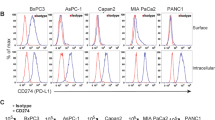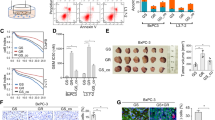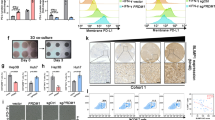Abstract
Combined injections into experimental tumor nodules of adenovirus encoding IL-12 and certain chemokines are capable to induce immune-mediated complete regressions. In this study, we found that the combination of two adenoviruses, one encoding IL-12 and other MIP3α (AdCMVIL-12+AdCMVMIP3α) was very successful in treating CT-26-derived colon carcinomas. However, in experimental tumors generated from the pancreatic carcinoma cell line Panc02 such combined treatment induces 50% of macroscopic complete regressions, although local relapses within 1 week are almost constant. We derived cell lines from such relapsing tumors and found that experimental malignancies derived from their inoculum were not amenable to treatment in any case with AdCMVIL-12+AdCMVMIP-3α. Importantly, relapsing cell lines were insensitive to in vitro induction of apoptosis by IFNγ, in clear contrast with the original Panc02 cells. Comparative analyses by cDNA arrays of relapsing cell lines versus wild-type Panc02 were performed revealing an important number of genes (383) whose expression levels were modified more than two-fold. These changes grouped in certain gene ontology categories should harbor the mechanistic explanations of the acquired selective resistance to IFNγ.
This is a preview of subscription content, access via your institution
Access options
Subscribe to this journal
Receive 12 print issues and online access
$259.00 per year
only $21.58 per issue
Buy this article
- Purchase on Springer Link
- Instant access to full article PDF
Prices may be subject to local taxes which are calculated during checkout










Similar content being viewed by others
References
Melero I et al. IL-12 gene therapy for cancer: in synergy with other immunotherapies. Trends Immunol 2001; 22: 113–115.
Dranoff GM, Mulligan RC . Gene transfer as cancer therapy. Adv Immunol 1995; 58: 417–454.
Bramson JL et al. Direct intratumoral injection of an adenovirus expressing interleukin-12 induces regression and long-lasting immunity that is associated with highly localized expression of interleukin-12. Hum Gene Ther 1995; 7: 1995–2002.
Emtage PC et al. A double recombinant adenovirus expressing the costimulatory molecule B7-1 (murine) and human IL-2 induces complete tumor regression in a murine breast adenocarcinoma model. J Immunol 1998; 160: 2531–2538.
Narvaiza I et al. Intratumoral coinjection of two adenoviruses, one encoding the chemokine IFN-gamma-inducible protein-10 and another encoding IL-12, results in marked antitumoral synergy. J Immunol 2000; 164: 3112–3122.
Palmer K et al. Combined CXC chemokine and interleukin-12 gene transfer enhances antitumor immunity. Gene Ther 2001; 8: 282–290.
Dilloo D et al. Combined chemokine and cytokine gene transfer enhances antitumor immunity. Nat Med 1996; 2: 1090–1095.
Putzer B et al. Interleukin 12 and B7-1 costimulatory molecule expressed by an adenovirus vector act synergistically to facilitate tumor regression. Proc Natl Acad Sci USA 1997; 94: 10889–10894.
Putzer BM et al. Large nontransplanted hepatocellular carcinoma in woodchucks: treatment with adenovirus-mediated delivery of interleukin 12/B7.1 genes. J Natl Cancer Inst 2001; 93: 472–479.
Martinet O et al. Immunomodulatory gene therapy with interleukin 12 and 4-1BB ligand: long-term remission of liver metastases in a mouse model. J Natl Cancer Inst 2000; 92: 931–936.
Zitvogel L et al. Interleukin-12 and B7.1 co-stimulation cooperate in the induction of effective antitumor immunity and therapy of established tumors. Eur J Immunol 1996; 26: 1335–1341.
Addison CL et al. Intratumoral coinjection of adenoviral vectors expressing IL-2 and IL-12 results in enhanced frequency of regression of injected and untreated distal tumors. Gene Ther 1998; 5: 1400–1409.
Levitsky HI . The best cytokine for the job. Nat Med 1997; 3: 126.
Mazzolini G et al. Regression of colon cancer and induction of antitumor immunity by intratumoral injection of adenovirus expressing interleukin-12. Cancer Gene Ther 1999; 6: 514–522.
Barajas M et al. Gene therapy of orthotopic hepatocellular carcinoma in rats using adenovirus coding for interleukin 12. Hepatology 2001; 33: 52–61.
Emtage PC et al. Adenoviral vectors expressing lymphotactin and interleukin 2 or lymphotactin and interleukin 12 synergize to facilitate tumor regression in murine breast cancer models. Hum Gene Ther 1999; 10: 697–709.
Luster AD . Chemokines – chemotactic cytokines that mediate inflammation. N Engl J Med 1998; 338: 436–445.
Greaves DR et al. CCR6, a CC chemokine receptor that interacts with macrophage inflammatory protein 3alpha and is highly expressed in human dendritic cells. J Exp Med 1997; 186: 837–844.
Fushimi T, Kojima A, Moore MA, Crystal RG . Macrophage inflammatory protein 3alpha transgene attracts dendritic cells to established murine tumors and suppresses tumor growth. J Clin Invest 2000; 105: 1383–1393.
Hellstrom I, Hellstrom KE . T cell immunity to tumor antigens. Crit Rev Immunol 1998; 18: 1–6.
Berke G . Unlocking the secrets of CTL and NK cells. Immunol Today 1995; 16: 343–346.
Yagita H et al. Role of perforin in lymphocyte-mediated cytolysis. Adv Immunol 1992; 51: 215–242.
Seliger B, Maeurer MJ, Ferrone S . Antigen-processing machinery breakdown and tumor growth. Immunol Today 2000; 21: 455–464.
Marincola FM, Jaffee EM, Hicklin DJ, Ferrone S . Escape of human solid tumors from T-cell recognition: molecular mechanisms and functional significance. Adv Immunol 2000; 74: 181–273.
Garrido F et al. Implications for immunosurveillance of altered HLA class I phenotypes in human tumours. Immunol Today 1997; 18: 89–95.
Bergmann-Leitner ES, Abrams SI . Influence of interferon gamma on modulation of Fas expression by human colon carcinoma cells and their subsequent sensitivity to antigen-specific CD8+ cytotoxic T lymphocyte attack. Cancer Immunol Immunother 2000; 49: 193–207.
Bergmann-Leitner ES, Abrams SI . Positive and negative consequences of soluble Fas ligand produced by an antigen-specific CD4(+) T cell response in human carcinoma immune interactions. Cell Immunol 2001; 209: 49–62.
Kaplan DH et al. Demonstration of an interferon gamma-dependent tumor surveillance system in immunocompetent mice. Proc Natl Acad Sci USA 1998; 95: 7556–7561.
Shankaran V et al. IFNgamma and lymphocytes prevent primary tumour development and shape tumour immunogenicity. Nature 2001; 410: 1107–1111.
Corbett TH et al. Induction and chemotherapeutic response of two transplantable ductal adenocarcinomas of the pancreas in C57BL/6 mice. Cancer Res 1984; 44: 717–726.
Clary BM et al. Inhibition of established pancreatic cancers following specific active immunotherapy with interleukin-2 gene-transduced tumor cells. Cancer Gene Ther 1997; 4: 97–104.
Qian C, Bilbao R, Bruna O, Prieto J . Induction of sensitivity to ganciclovir in human hepatocellular carcinoma cells by adenovirus-mediated gene transfer of herpes simplex virus thymidine kinase. Hepatology 1995; 22: 118–123.
Ashburner M et al. Gene ontology: tool for the unification of biology. The Gene Ontology Consortium. Nat Genet 2000; 25: 25–9.
Caruso M et al. Adenovirus-mediated interleukin-12 gene therapy for metastatic colon carcinoma. Proc Natl Acad Sci USA 1996; 93: 11302–11306.
Trinchieri G . Interleukin-12: a cytokine at the interface of inflammation and immunity. Adv Immunol 1998; 70: 83–243.
Sgadari C, Angiolillo AL, Tosato G . Inhibition of angiogenesis by interleukin-12 is mediated by the interferon-inducible protein 10. Blood 1996; 87: 3877–3882.
Robertson MJ et al. Immunological effects of interleukin 12 administered by bolus intravenous injection to patients with cancer. Clin Cancer Res 1999; 5: 9–16.
Leonard JP et al. Effects of single-dose interleukin-12 exposure on interleukin-12-associated toxicity and interferon-gamma production. Blood 1997; 90: 2541–2548.
Grohmann U et al. Positive regulatory role of IL-12 in macrophages and modulation by IFN-gamma. J Immunol 2001; 167: 221–227.
Munder M, Mallo M, Eichmann K, Modolell M . Murine macrophages secrete interferon gamma upon combined stimulation with interleukin (IL)-12 and IL-18: a novel pathway of autocrine macrophage activation. J Exp Med 1998; 187: 2103–2108.
Sad S, Marcotte R, Mosmann TR . Cytokine-induced differentiation of precursor mouse CD8+ T cells into cytotoxic CD8+ T cells secreting Th1 or Th2 cytokines. Immunity 1995; 2: 271–279.
Boehm U, Klamp T, Groot M, Howard JC . Cellular responses to interferon-gamma. Annu Rev Immunol 1997; 15: 749–795.
Shyu RY, Su HL, Yu JC, Jiang SY . Direct growth suppressive activity of interferon-alpha and -gamma on human gastric cancer cells. J Surg Oncol 2000; 75: 122–130.
Ruiz-Ruiz C, Munoz-Pinedo C, Lopez-Rivas A . Interferon-gamma treatment elevates caspase-8 expression and sensitizes human breast tumor cells to a death receptor-induced mitochondria-operated apoptotic program. Cancer Res 2000; 60: 5673–5680.
Wu AJ et al. Interferon-gamma induced cell death in a cultured human salivary gland cell line. J Cell Physiol 1996; 167: 297–304.
Suk K et al. Interferon gamma (IFNgamma) and tumor necrosis factor alpha synergism in ME-180 cervical cancer cell apoptosis and necrosis. IFNgamma inhibits cytoprotective NF-kappa B through STAT1/IRF-1 pathways. J Biol Chem 2001; 276: 13153–13159.
Veldman RJ, Klappe K, Hoekstra D, Kok JW . Interferon-gamma-induced differentiation and apoptosis of HT29 cells: dissociation of (glucosyl)ceramide signaling. Biochem Biophys Res Commun 1998; 247: 802–808.
Lee KY, Anderson E, Madani K, Rosen GD . Loss of STAT1 expression confers resistance to IFN-gamma-induced apoptosis in ME180 cells. FEBS Lett 1999; 459: 323–326.
Jiang MC et al. IRF-1-mediated CAS expression enhances interferon-gamma-induced apoptosis of HT-29 colon adenocarcinoma cells. Mol Cell Biol Res Commun 2001; 4: 353–358.
Naujokat C, Sezer O, Possinger K . Tumor necrosis factor-alpha and interferon-gamma induce expression of functional Fas ligand on HT29 and MCF7 adenocarcinoma cells. Biochem Biophys Res Commun 1999; 264: 813–819.
Wu TD . Analysing gene expression data from DNA microarrays to identify candidate genes. J Pathol 2001; 195: 53–65.
Dwight SS et al. Saccharomyces Genome Database (SGD) provides secondary gene annotation using the Gene Ontology (GO). Nucleic Acids Res 2001; 30: 69–72.
Martínez-Chantar ML et al. Spontaneous oxidative stress and liver tumors in mice lacking methionine adenosyltransferase 1A. FASEB J 2002; 16: 1292–2004.
Han BH et al. Clusterin contributes to caspase-3-independent brain injury following neonatal hypoxia-ischemia. Nat Med 2001; 7: 338–343.
McLaughlin L et al. Apolipoprotein J/clusterin limits the severity of murine autoimmune myocarditis. J Clin Invest 2000; 106: 1105–1113.
Michl P et al. Claudin-4: a new target for pancreatic cancer treatment using Clostridium perfringens enterotoxin. Gastroenterology 2001; 121: 678–684.
de Silva DM, Aust SD . Ferritin and ceruloplasmin in oxidative damage: review and recent findings. Can J Physiol Pharmacol 1993; 71: 715–720.
Bussolati B et al. PAF produced by human breast cancer cells promotes migration and proliferation of tumor cells and neo-angiogenesis. Am J Pathol 2000; 157: 1713–1725.
Yan H et al. Small changes in expression affect predisposition to tumorigenesis. Nat Genet 2002; 30: 25–6.
Acknowledgements
We thank Dr Bendandi and Tirapu for critical reading and helpful discussion. Juan Percaz, Javier Guillen, Izaskun Gabari and Celia Gomar are acknowledged for their technical assistance. The team at Medplant Genetics is acknowledged for assistance with the microarray technology. Financial support was from CICYT (SAF 99/0039), Gobierno de Navarra and grants from Fundación Ramón Areces and Inés Bemberg.
Author information
Authors and Affiliations
Rights and permissions
About this article
Cite this article
Mazzolini, G., Narvaiza, I., Martinez-Cruz, L. et al. Pancreatic cancer escape variants that evade immunogene therapy through loss of sensitivity to IFNγ-induced apoptosis. Gene Ther 10, 1067–1078 (2003). https://doi.org/10.1038/sj.gt.3301957
Received:
Accepted:
Published:
Issue Date:
DOI: https://doi.org/10.1038/sj.gt.3301957
Keywords
This article is cited by
-
Immunotherapeutic Synergy Between Anti-CD137 mAb and Intratumoral Administration of a Cytopathic Semliki Forest Virus Encoding IL-12
Molecular Therapy (2012)
-
Angiotensin II type 2 receptor signaling significantly attenuates growth of murine pancreatic carcinoma grafts in syngeneic mice
BMC Cancer (2010)
-
Immunotherapy for liver tumors: present status and future prospects
Journal of Biomedical Science (2009)
-
New therapies for hepatocellular carcinoma
Oncogene (2006)



